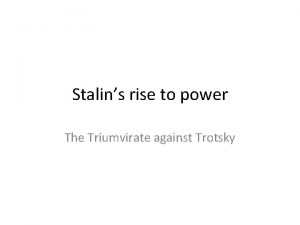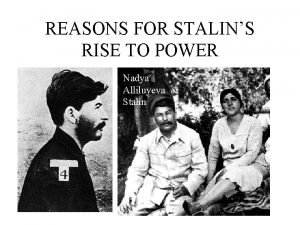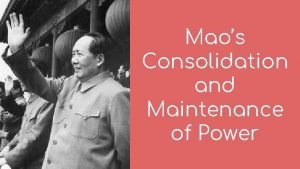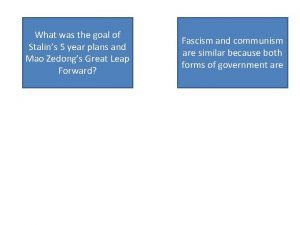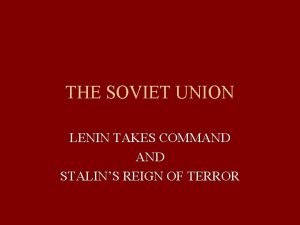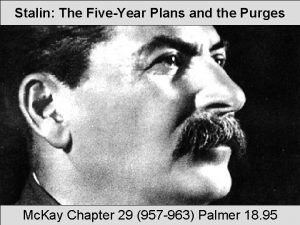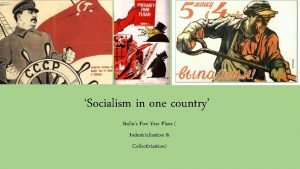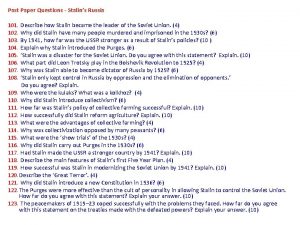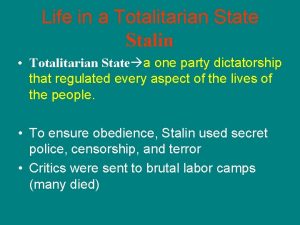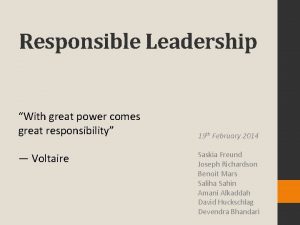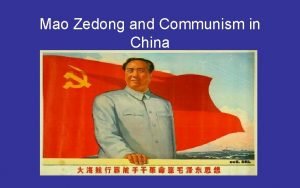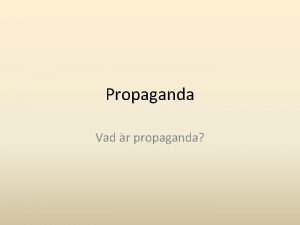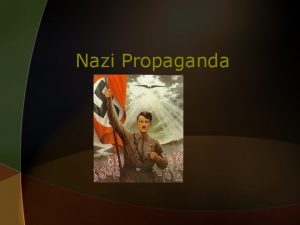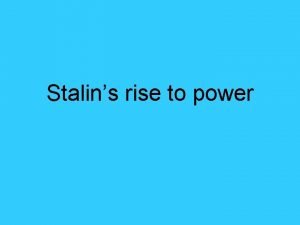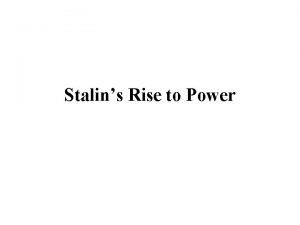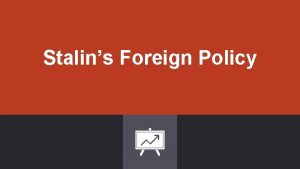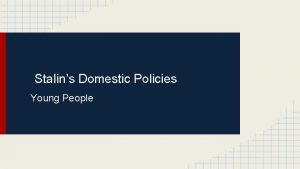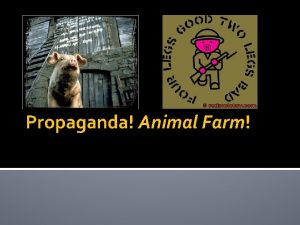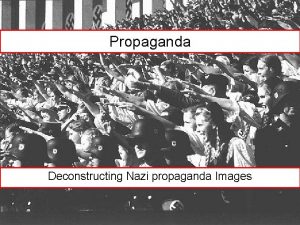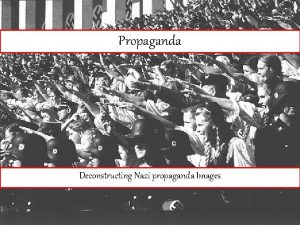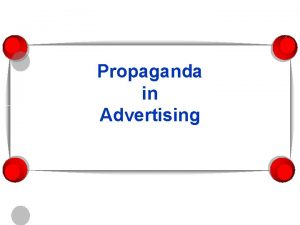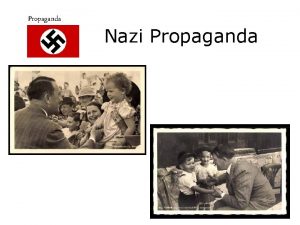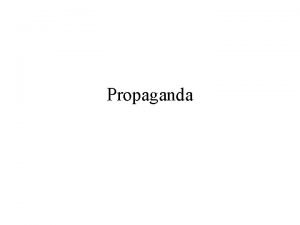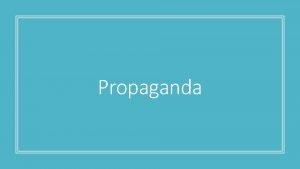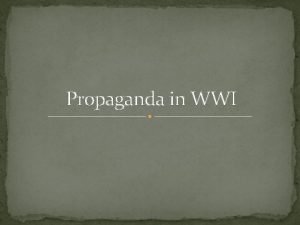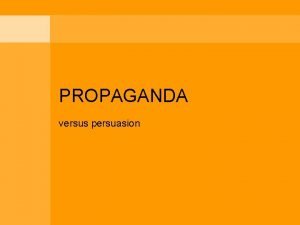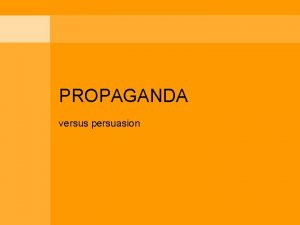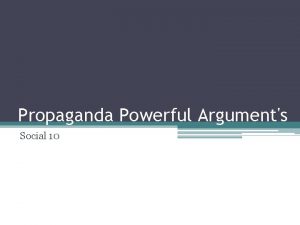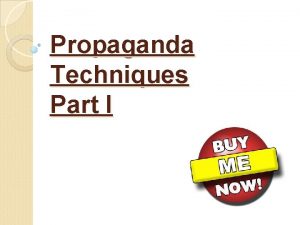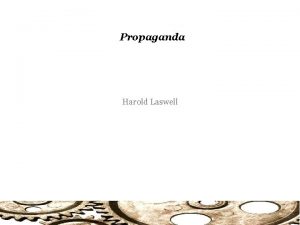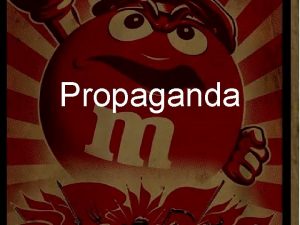Stalins Consolidation of Power TerrorPurges Propaganda The Great








































- Slides: 40

Stalin’s Consolidation of Power Terror/Purges & Propaganda

The Great Purge Introduction

What were Stalin’s Purges? “purge” can also be translated to “terror” Previous purges involved the persecutions of: ➢ Kulaks (wealthy peasants) ➢ NEPmen (people who profited from the 1920 s New Economic Policy) ➢ Clergymen ➢ Former oppositionists

The Great Purge ❖ The Great Purge took place between 1934 and 1938 The Great Purge is characterized by the mass incarceration and execution of Communists leaders and party members, members of the Red Army, and the Intelligentsia ❖ Thousands of Stalin’s opponents were arrested and executed ❖ Millions of people were sent to Gulag labour camps ➢ Many of them died

“Upon Stalin’s rise to power, some members of the former Bolshevik party began to question his authority. By the mid-1930 s, Stalin believed anyone with ties to the Bolsheviks or Lenin’s government was a threat to his leadership and needed to go. ”

The Great Purge Why/How it Happened

Who was Sergei Kirov? Sergei Kirov ❖ He became a Marxist and joined the Social Democratic Party (SDP) in 1904. ❖ In 1926 he was appointed head of the Leningrad party organization. ❖ He joined the Politburo in 1930

What Started the Great Purge? Sergei Kirov ❖ Was originally a supporter of Stalin ➢ Stalin treated him like a son ❖ Began to gain power and popularity that threatened Stalin’s consolidation ❖ Assassinated in 1934 by Leonid Nikolayev ➢ who had been expelled from the Communist Party and wanted revenge

What Started the Great Purge? cont. Kirov’s assassination = Stalin’s excuse for The Great Purge ❖ Stalin arrested his political opposition as potential “suspects” ➢ He would go on to eliminate all the original Bolsheviks that participated in the Russian Revolution of 1917. Stalin was behind Kirov’s assassination vs. Historians debate: That was made up by Trotsky supporters to discredit Stalin vs. Stalin knew, and let it happen

What were Stalin’s Motives? ❖ Getting rid of opposition ➢ Stalin wanted to be an absolute autocrat ➢ He was “paranoid” ❖ Creating unity ➢ Make the country strong ➢ To preserve and enhance the Communist Party. ❖ Faster industrialization ➢ By using prison labour from the Gulag camps

The Great Purge The Victims

Who was killed? The Great Purge started with 3 main targets: ❖ The Communist leadership ➢ 93 of the 139 Central Committee members ❖ The Communist Party ➢ Approximately 1 million of the 3 million members ❖ The armed forces ➢ 81 of the 103 generals and admirals

Who was killed? cont. This then expanded to include: ➢ ethnic minorities, foreigners ➢ artists, scientists, intellects, writers, ➢ peasants, and ordinary citizens. ❖ People who had simply annoyed their neighbours were turned in to the NKVD and arrested ❖ Stalin also signed a decree that made families liable for the crimes committed by a husband or father

Historians disagree on the total death toll of The Great Purge, however the number is believed to be anywhere from 750 thousand to over 20 million

Why were they targets? ❖ Stalin executed anyone within The Communist leadership who presented themselves as potential opposition ➢ This included big names such as: Grigory Zinovyev, Lev Kamenev, Ivan Smirnov, G. L. Pyatakov, G. Y. Sokolnikov, L. P. Serebryakov, Karl Radek, Nikolay Bukharin and Aleksey Rykov who would late be involved in the Moscow Trials ❖ Any members of The Communist Party who supported/ anyone associated with the opposition were arrested as well

Why were they targets? cont. ❖ Stalin became convinced that the leaders of the Red Army were involved in a plot to overthrow him ❖ The Germans exploited Stalin’s paranoia by forging documents implicating, Soviet chief of Staff, Marshal Tukhachevsky as a German Spy ➢ Tukhachevsky was executed in 1937 ➢ Over half the Russian officer corps, around 35, 000 men, were executed or banished

The Great Purge The Show Trials

The Moscow Trials AKA The “Show Trials” ❖ The court trials of the accused were public with foreign journalists invited ❖ The show trials were heavily manipulated ➢ “Show Trial” everything was staged ➢ Defendants were forced into confession after being interrogated, threatened and tortured.

The “Show Trials” cont. The purpose of the Show Trials were: ❖ To prove to those in doubt that ‘enemies of the state’ were still a threat to Stalin ❖ To present a “very public admission of betraying the revolution and therefore the people. ” *so they also played a large role in Stalin’s propaganda

The First Show Trial- August 1936 The defendants: Grigory Zinovyev, Lev Kamenev, and Ivan Smirnov Along with 13 co-defendants, they were accused of: ➢ Joining Trotsky in 1932 to remove Stalin from power ➢ The assassination of Sergey Mironovich Kirov ➢ Planning to murder Stalin and his close political associates On August 24, 1936, the court found the defendants guilty and ordered their executions.

The Second Show Trial- January 1937 The defendants: G. L. Pyatakov, G. Y. Sokolnikov, L. P. Serebryakov, and Karl Radek Along with 17 co-defendants, they were accused of: ➢ Forming an “anti-Soviet Trotskyite centre ➢ Working for Germany and Japan ➢ Intending to overthrow the Soviet government and restore capitalism They were found guilty on January 30, 1937. Sokolnikov, Radek, and two others were given 10 -year sentences, and the rest were executed.

The Third Show Trial- March 1938 The defendants: Nikolay Bukharin and Aleksey Rykov A total of 21 defendants were accused of: ➢ Numerous acts of sabotage and espionage ➢ Being responsible Kirov’s death ➢ As well as some other individual charges All the defendants except three were sentenced to death on March 13, 1938.

The Great Purge Other Important Details

The Role of the NKVD ❖ In 1933, the Government Political Administration (GPU) became known as the People's Commissariat for Internal Affairs (NKVD) ❖ They were the Communist “Secret Police” ❖ The NKVD carried out the arrests during the Great Purge ➢ The majority of the people in NKVD prisons died *It was a member of the NKVD who assigned Leonid Nikolayev the job of assassinating Sergei Kirov

When/Why did the Purges end? ❖ The Great Purge officially ended in 1938 ❖ Stalin had eliminated his opposition, and created the fear he wanted among those who remained ❖ Many historians argue that Stalin was never really finished with his purging until Leon Trotsky was assassinated in 1940

The Role of Leon Trotsky Stalin’s Greatest Opposition

Profile of Leon Trotsky ❖ ❖ ❖ Extremely intelligent Charismatic Good leadership qualities Lack of political intuition Prone to arrogance, dismissiveness and sarcasm It was this over-confidence that allowed Stalin to surpass him, and take control of the party

Trotsky “displayed excessive self-assurance and… excessive preoccupation with the purely administrative side of the work. ”. - Vladimir Lenin (1922 ‘political testament’)

Why Was Trotsky Significant? ❖ Trotsky and Stalin were rivals from the very beginning ❖ Trotsky was Stalin’s main opposition for leadership of the party ➢ Given how it was assumed that Trotsky would be Lenin’s successor, he became an even greater threat to Stalin ❖ Trotsky openly criticized Stalin ➢ When Stalin came into power but also while Lenin was still alive ❖ Stalin launched a propaganda counterattack against Trotsky

Trotsky recalls the ‘yellow glint’ of animosity which he noticed in Stalin’s eyes during their first conversation in Vienna, in 1913. From the beginning he treated Stalin with the contempt that he never abandoned for a moment while he was writing this book. - Isaac Deutscher

Why Was Trotsky Significant? ❖ Trotsky and Stalin were rivals from the very beginning ❖ Trotsky was Stalin’s main opposition for leadership of the party ➢ Given how it was assumed that Trotsky would be Lenin’s successor, he became an even greater threat to Stalin ❖ Trotsky openly criticized Stalin ➢ When Stalin came into power but also while Lenin was still alive ❖ Stalin launched a propaganda counterattack against Trotsky

Trotsky Timeline 1925: Trotsky was removed from his post in the war commissariat 1926: Trotsky was expelled from the Politburo 1927: Trotsky was expelled from the Communist Party January 1929: Trotsky was expelled from the Soviet Union outright. January 1928, Trotsky began his internal exile in Alma-Ata

Trotsky and The Great Purge ❖ The first people arrested during The Great Purge were known supporters of Trotsky ➢ Trotsky was safe, living out of the country at the time ❖ Trotsky was sentenced to death in absentia during the Moscow Trials ❖ He was living in exile in Mexico when he was assassinated with an ice pick in 1940

The Relationship Between Stalin and Trotsky ❖ Stalin really had it out for Trotsky “He (Trotsky) was oppressed by the nightmare of the Moscow purge trials, in which he had been depicted as the centre of a most sinister conspiracy. All his children had died in mysterious circumstances which led him to believe that they had fallen victims to Stalin’s vengeance. " -Isaac Deutscher ❖ As previously mentioned, many historians would argue that Stalin only truly felt satisfied with his purging once Trotsky was dead

Propaganda Cult of Personality

Stalin’s Cult of Personality ➢ Images of Stalin were designed to make him look powerful (taller + more physically fit) as well as benevolent ➢ All achievements were credited to Stalin ➢ He was “The wisest man of the 20 th century” and “The genius of the age” ➢ The Soviet people were taught that he was never wrong ➢ His favourite form of propaganda were paintings and sculptures

Cult of Personality cont. ➢ The cult of Stalin replaced churches with its icons ➢ Anything that might reflect badly on Stalin was censored ➢ Propaganda was everywhere - pictures, statues, continuous praise and applause for Stalin ➢ History textbooks & photographs were changed to make him the hero of the Revolution ➢ Names & photographs of purged people were obliterated from the record

How did the Great Purge Contribute to Propaganda? ❖ The Show Trials ➢ The publicity ➢ The exaggeration ➢ The Forced Confessions

Zinoviev: “I would like to repeat that I am fully and utterly guilty. I am guilty of having been the organiser, second only to Trotsky , of that block whose chosen task was the killing of Stalin. I was the principal organiser of Kirov’s assassination. The party saw where we were going, and warned us. Stalin warned us scores of times but we did not heed his warnings. We entered into an alliance with Trotsky” Kamenev: “I Kamenev, together with Zinoviev and Trotsky, organised and guided this conspiracy. My motives? I had become convinced that the party’s – Stalin’s policy – was successful and victorious. We, the opposition, had banked on a split in the party, but this hope proved groundless. We could no longer count on any serious domestic difficulties to allow us to overthrow Stalin’s leadership. We were actuated by boundless hatred and by lust of power. ”

How did the Great Purge Contribute to Propaganda? cont. ❖ Stalin’s brutality ➢ Lessened the likelihood of future opposition by inciting fear ➢ Made his people dependant on the state ➢ Changed the people's opinion of Stalin for the worse
 Bourbon triumvirate background
Bourbon triumvirate background Nadya stalin
Nadya stalin Mao consolidation and maintenance of power
Mao consolidation and maintenance of power Stalins goal
Stalins goal Stalins reign
Stalins reign Stalins 5 year plan
Stalins 5 year plan Collectivization
Collectivization Stalins five year plans
Stalins five year plans Stalin kd
Stalin kd Life in a totalitarian state
Life in a totalitarian state Egoistic leadership
Egoistic leadership With great power comes great responsibility
With great power comes great responsibility Draw the power triangle
Draw the power triangle Great leap forward propaganda
Great leap forward propaganda Hình ảnh bộ gõ cơ thể búng tay
Hình ảnh bộ gõ cơ thể búng tay Ng-html
Ng-html Bổ thể
Bổ thể Tỉ lệ cơ thể trẻ em
Tỉ lệ cơ thể trẻ em Gấu đi như thế nào
Gấu đi như thế nào Glasgow thang điểm
Glasgow thang điểm Chúa yêu trần thế alleluia
Chúa yêu trần thế alleluia Các môn thể thao bắt đầu bằng tiếng chạy
Các môn thể thao bắt đầu bằng tiếng chạy Thế nào là hệ số cao nhất
Thế nào là hệ số cao nhất Các châu lục và đại dương trên thế giới
Các châu lục và đại dương trên thế giới Cong thức tính động năng
Cong thức tính động năng Trời xanh đây là của chúng ta thể thơ
Trời xanh đây là của chúng ta thể thơ Mật thư tọa độ 5x5
Mật thư tọa độ 5x5 Phép trừ bù
Phép trừ bù Phản ứng thế ankan
Phản ứng thế ankan Các châu lục và đại dương trên thế giới
Các châu lục và đại dương trên thế giới Thơ thất ngôn tứ tuyệt đường luật
Thơ thất ngôn tứ tuyệt đường luật Quá trình desamine hóa có thể tạo ra
Quá trình desamine hóa có thể tạo ra Một số thể thơ truyền thống
Một số thể thơ truyền thống Cái miệng bé xinh thế chỉ nói điều hay thôi
Cái miệng bé xinh thế chỉ nói điều hay thôi Vẽ hình chiếu vuông góc của vật thể sau
Vẽ hình chiếu vuông góc của vật thể sau Nguyên nhân của sự mỏi cơ sinh 8
Nguyên nhân của sự mỏi cơ sinh 8 đặc điểm cơ thể của người tối cổ
đặc điểm cơ thể của người tối cổ Ví dụ về giọng cùng tên
Ví dụ về giọng cùng tên Vẽ hình chiếu đứng bằng cạnh của vật thể
Vẽ hình chiếu đứng bằng cạnh của vật thể Phối cảnh
Phối cảnh Thẻ vin
Thẻ vin
